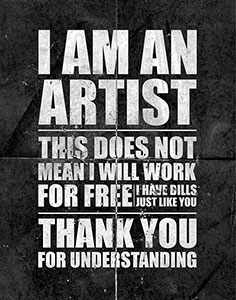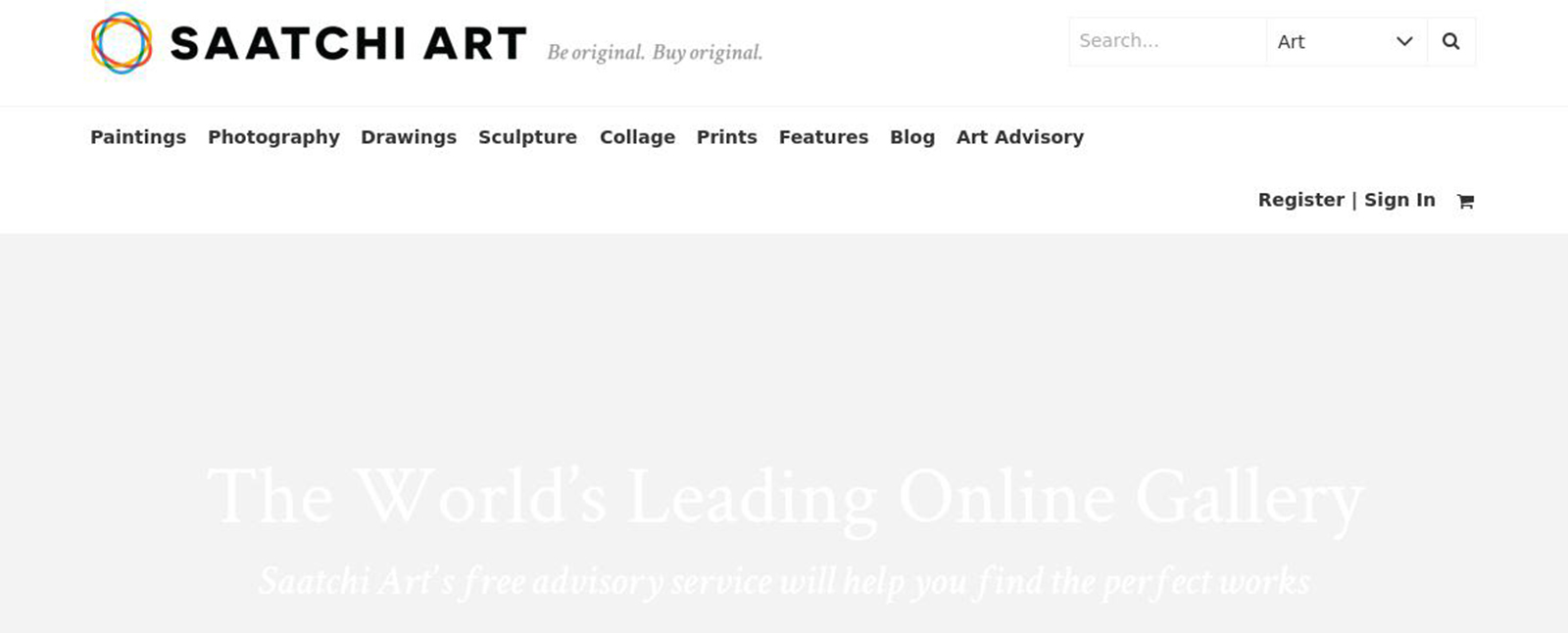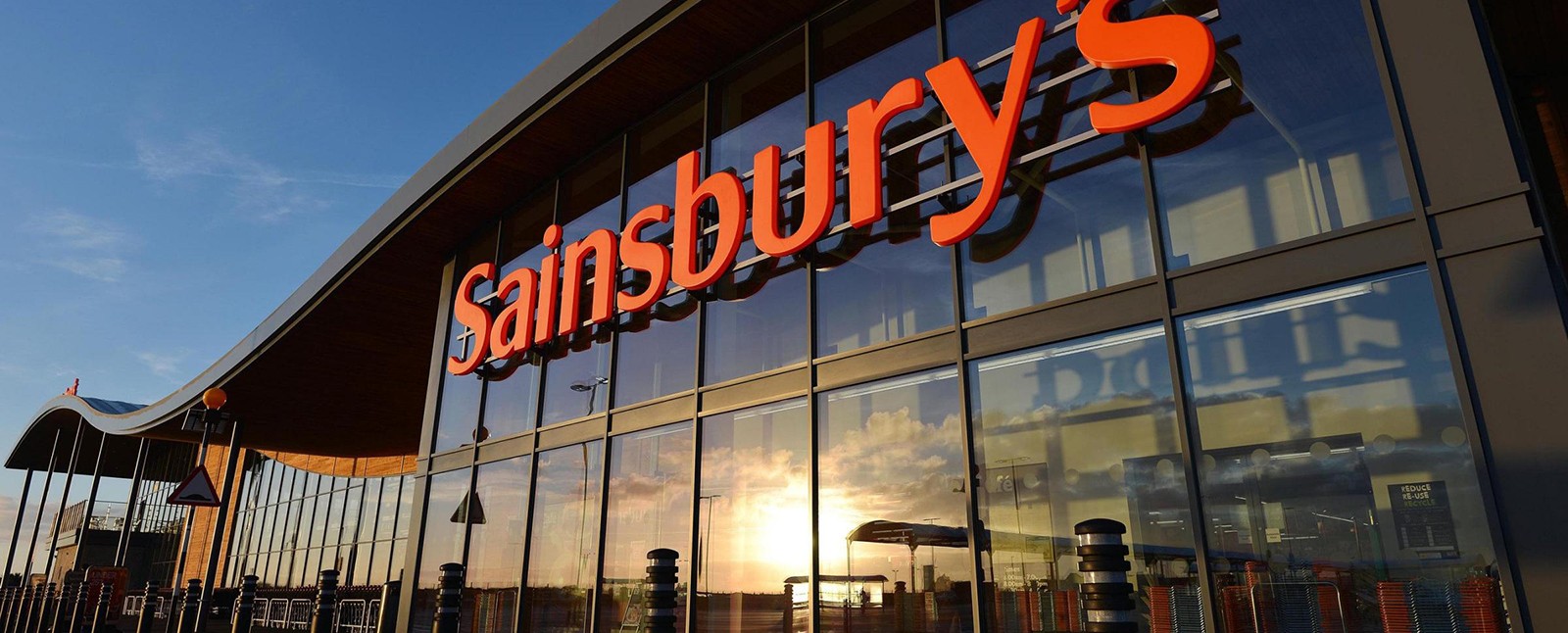
If you are a creative I am sure you have been down this road. Someone has the cheek to ask you to use your talents for free. Whether it’s a friend or family member, or a corporation saying that it will be good exposure or that “if selected you will be paid“, it all amounts the same thing, total disrespect for you, your skill and the art industry. Now, recently there was an ad in a UK based paper that was from J Sainsbury’s corporation (a large supermarket chain, that pander to the upper-middle class ~ and I say that for a reason) in which it stated it was looking for the services of a creative. I will let the advert speak for itself.
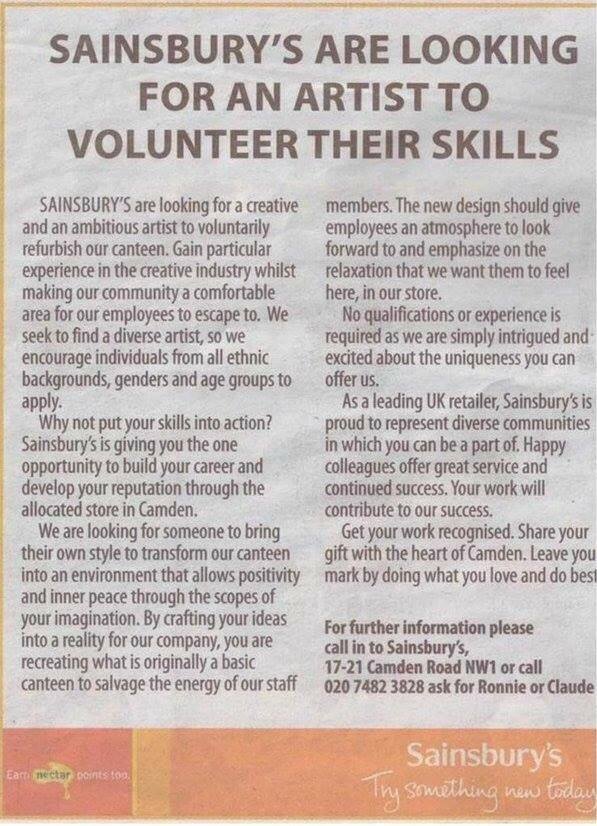
I am sure you have seen it. So, not only is it a London based J Sainsbury’s (highest income region in UK) in the heart of Camden (as the ad states), but the fact that J Sainsbury’s profit for 2014/2015 was £681m is another damning attribute to the ‘oh-so woeful’ joke. Even though it was a fall of 14.7%, I think you would agree it is a healthy figure next to some of the earnings of hard working creatives. The real punch to the gut for a great deal of creative talents out there however, is that it is become a common place rather than a rarity. At this point, I will mention two groups trying to stop the surge of such abuse toward artist’s work state. The first is the well know No!Spec organisation that very often states and points out the miscarriage in justice that are thrown on hard working artists. The second place of interest in this matter is a place called Spec Watch. This Twitter feed often updates with the information regarding people’s activities in this matter. So, what is it all about?
The process (which most clients don’t even understand probably) is called speculative work. This is how it is described on the No!Spec website:
Spec work is any kind of creative work, either partial or completed, submitted by designers to prospective clients before designers secure both their work and equitable fees. Under these conditions, designers will often be asked to submit work in the guise of a contest or an entry exam on existing jobs as a “test” of their skill. In addition, designers normally lose all rights to their creative work because they failed to protect themselves with a contract or agreement. The clients often use this freely-gained work as they see fit without fear of legal repercussion.
So, basically anything that is asking you to do creative work on the promise of payment (usually if you are selected from countless creatives) is known as speculative work. There are even sites set up these days, to make a living out of enticing artists who want to be recognised, to do such work. One noticeable one is Talenthouse. Basically the site is an online portfolio, but it also runs a service called “Creative Invites”. This in itself is basically getting artists/creatives to send in work to speculative projects, hoping they will get selected to be used in the acclaimed project. Here is their recent frontage.
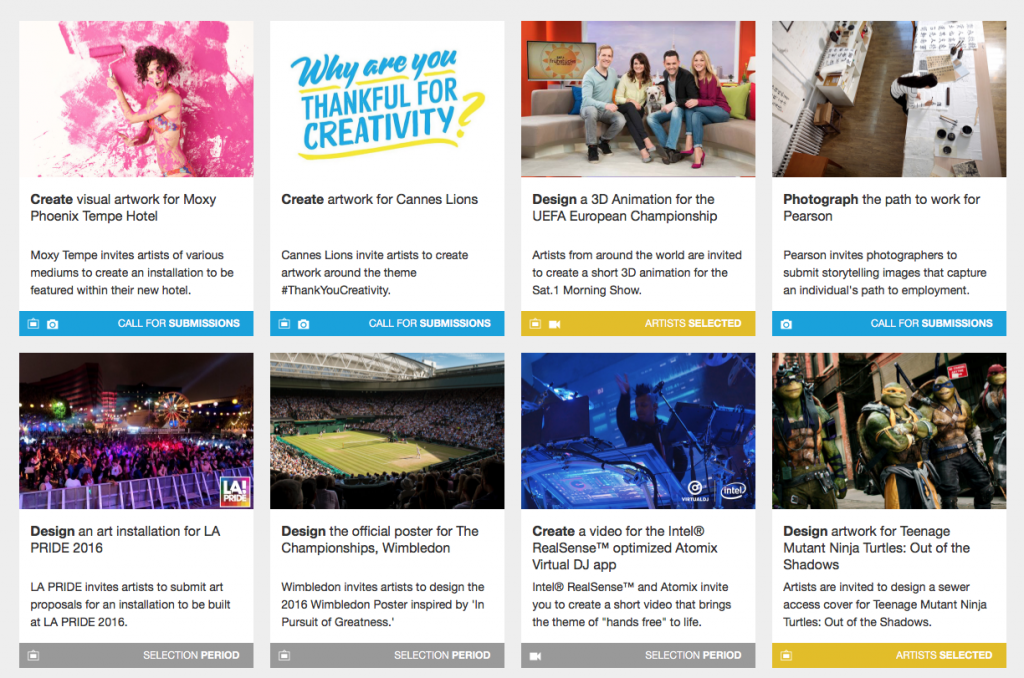
The sad fact is, even though the selected artist does get some remuneration in the challenge, there are hundreds who send in ideas that are not selected or paid. It almost comes to a point where the masses accept this process as part of their existence as a creative; ‘better to hope than starve’. But, the industry that is enabling this type of economic slavery is in itself making money off this work. Plus, it should be pointed out that a lot of these sites doing this type of work ethic, don’t state anywhere in the terms in uploading the artwork that you, the artist, retain the copyright on the artwork being given for free. That is another issue that can be discussed at length another time, and the real need for creatives to have agreements on ownership as well as intellectual property rights. As well as the discussion of never giving away open files! Open files are basically the files used to create the artworks in the digital arena (such as an .ai file or a .psd, or even a layered .tiff). Clients do NOT have the rights to your work files. They hire you for a printable image and if that is what you give them, then the contract is final. Here is some advise from AIGA, but basically, it’s another simple ploy to get files that they can manipulate in the future to cut the cost of paying you a pittance to do the work originally.
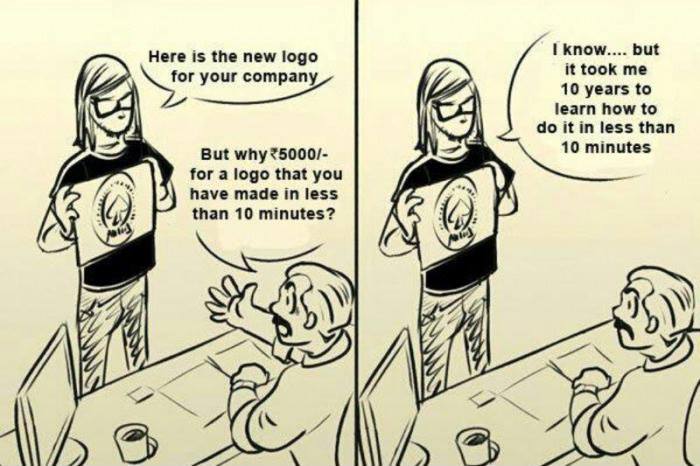
The sad truth is that for many reasons art and design is being seen as a service industry that has it’s value in the product rather than the service. People often band this term around about ‘talent’! Surely if talent was something special it would a) be classed as a skilled job and b) have a value to that talent. After all, like many professionals we creatives did go to University/Polytechnic to seek the skills to hone our talents into a commercial viability. As a part-time educator I am often asked by my students to advise them on such matters of ‘clients’ asking for “an arm and a leg” output for a pittance of pay. My advise is simple, think about what you are worth? Also, think about what it does to the industry. Since the industrial revolution and the advent of mass production, and now digital distribution online with derivative UGC being commonplace, there is no wonder that art is seen as a free entity. Let’s look at this from another angle.
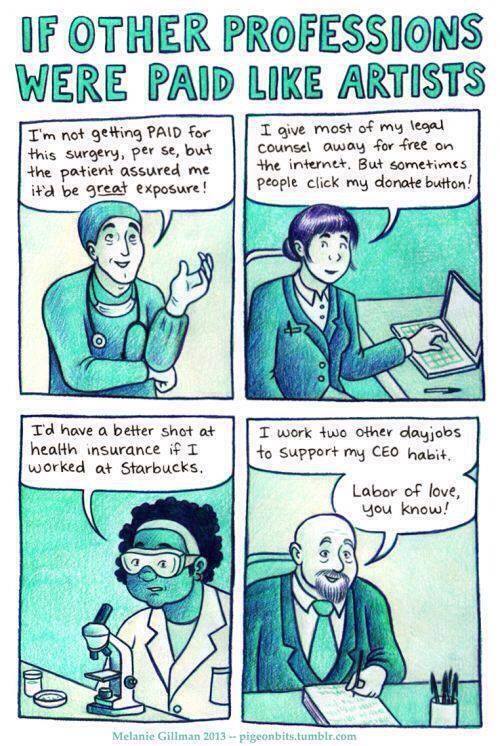
It is true. Many professionals would not do much work if the idea of not being paid for that service was on the table. This is not to say that there are not many kind souls who do give their services free in certain occasion, but as a methodology of a growing industry, it is rare. Also see this humorous video about the matter, from Zulu Alpha Kilo! There are two main aspects (maybe three) that drive this attitude about creative people’s work ethics. The first and really damning is the dual notion that creatives are lazy, and if not they enjoy their work so much it shouldn’t be seen as a job. Neither of these two statements are true, of course. Many of my creative colleagues, and myself included, work MORE hours than most standard professionals. Even to the extent of bring the work home with us (which is easy when ideas are always bouncing around the head). Plus who said it was not a part of society to actually enjoy what your do, and more over be paid for that fact?
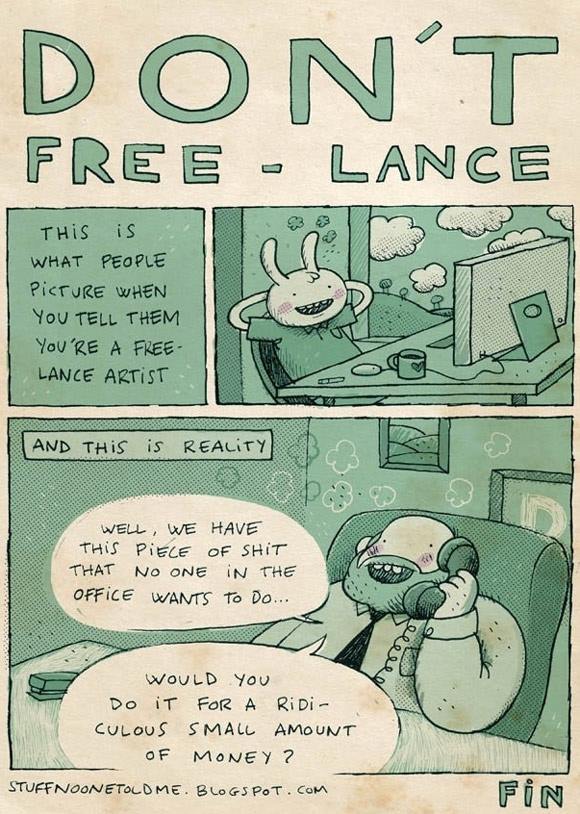
Another point that denotes this negative attitude in artist services is the way that the internet services the cost of art. Everything is done with a relentless cost cutting aspect to getting art (if those who use the internet bother paying for the art) for the lowest price. One reason I stopped adding pieces to Stock Sites was the simple fact, and without consultation to that artist (again) they automatically get thrown into the ‘subscription’ marketplace. This allows people, to sign a deal (that makes money for the stock site) that allows them to download between 10-30 images a week/month for a small fee. This means the artist ends up getting something like ¢0.25 a sale. OK, based on a model where everyone in the world is wanting your image and you sell 1,000’s, that isn’t such a bad deal. You can sit there a see the money roll in. However, two aspects to that mode of thinking. These sites DON’T curate the work well, and anyone these days can upload anything to sell, so you get lost in the masses. That equates to less sales, less money and disrespect. The other issue is that they mostly expect .eps files (which surprisingly sell better), and bitmap images are frowned upon and sell less. Refer to the part above about giving open files to clients! Those who see the internet as an Aladdin’s cave of free wares is becoming a very bad aspect to the digital age. A file shared incorrectly can be spread around the web like wildfire and no income is made from it. That is before we start talking about data mining robots looking for images and entry to sites to get free images, etc. The issue just becomes compounded.
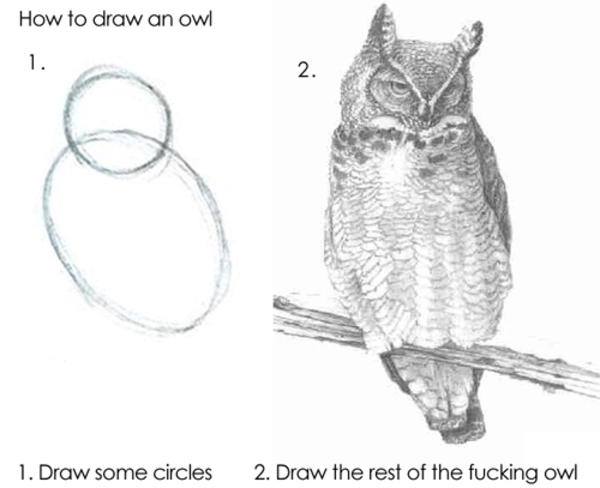
In a recent talk to the Behance Portfolio Review I stated some points about “What is Creativity?” After all, if you see this as service industry, as much as the tax man does your taxes, your doctor performs your operation, your plumber fixes your tap, then the talent is what you pay for. It shouldn’t be given away free, especially with such a fantastic descriptor like “talent” describing our work.
people possessing natural aptitude or skill
If a footballer possesses such ‘talent’ is he asked to kick a ball around for free on a Saturday afternoon at Old Trafford? I think not. But even more that technology has seemingly stripped away the craftsmanship involved in creative work and so turned it from a service to a reproducible mechanism, the loss of understanding in the simplest forms of communication also end up throwing insult onto the matter. This is the actual root meaning of the word ‘talent’:
Old English talente, talentan (as a unit of weight), from Latin talenta, plural of talentum ‘weight, sum of money’, from Greek talanton.
(To quote Alanis Morissette) Now, isn’t that ironic! So, (referring to the owl, which does crack me up everytime I see it), when asked “How did I do that?” or “Can you teach me to draw like that?” I simply tell the inquirer to buy a pile of paper, some pencils and then come back in twenty years. Talent is not a technique. Technique is a methodology that in art will result in a style. Talent is the ability to draw all the necessary aspects of creativity together to form that image, using the given technique. Now, is that worth something? I think so, and am constantly bemused when watching episodes of “Mad Men“. As, in the heyday of good creativity (without computer I may add), these talented creatives were EVEN paid for their ideas!! Yes, can you image that.
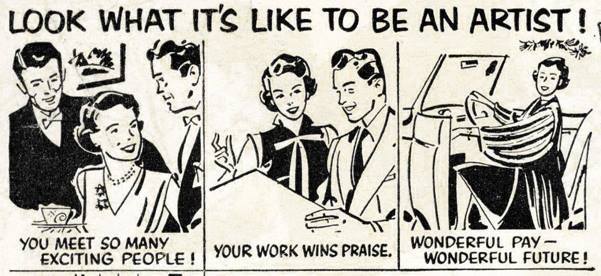
Now, if it’s not hard enough to fight this social labelling of what a creative is, there is this constant struggle that capitalism has brought around, where you have to be competitive, you have to be affordable, but on top of that you have to bend over and be fucked by the client. So, failing an artistic revolution what do us ‘talented’ creatives have to face in our future? Well, and not digging into the idea of the looming Orphan Works Bill, there is a sad process behind the value of art. Art builds cultures, and if the value you place on that art is what you then systematically place on the culture it has built, then what can really be said about that culture? So to sum it all up and to revert back to the J Sainsbury’s story. We, as a group of unamalgamated talents, need to understand that we make the change. We have to do something about this raping of our market. We have to stand up for our rights. Make things more business like, if business wants our services. It’s only fair (and there are a plethora of images I can place here to make that rally cry) as creativity to have my practice recognised a career. Too many, it is a way to place food on the table (segway here), and to keep the wolf from the door. Anyway, some days after the initial J Sainsbury’s insult, a creative mind placed a counter notice to the call for ‘free’ talent. Again I will let it speak for itself.

In a society that is fast failing many morality tests, it should not come down to petty arguments and excuses like “It’s on the web, so it must be free!“, or “My uncle paints for a hobby, why do you charge money?” or “It will only take you five minutes.” If you feel a need to judge the value of art, or artists remember that Buddhist analogy of “Never judge a person until you have walked in their shoes.” Life as a professional creative is not easy. I know I wouldn’t throw it on anyone, but it’s a fantastic way to get down to root aspects of humanity and use communication for a good reason. Respect artists and what they do!
